Physical Address
304 North Cardinal St.
Dorchester Center, MA 02124
Mechanical large bowel obstruction is four to five times less common than small bowel obstruction and differs significantly in terms of cause ( Table 46.1 ), pathophysiology, therapy, and prognosis. Colon obstruction is most often the result of a neoplasm ( Table 46.2 ), whereas most small bowel obstructions are caused by adhesions. , A number of extracolonic disease processes, including gynecologic diseases, can secondarily involve the large bowel, leading to obstruction or formation of strictures and fistulas.
| Intrinsic Defects | Extrinsic Defects |
|---|---|
| Neoplasms | Volvulus |
| Benign | Secondary |
| Malignant | Primary |
| Inflammatory | Hernias |
| Diverticulitis | Internal |
| Ulcerative colitis | External |
| Crohn’s disease | Adhesions |
| Amebiasis | Mass compression |
| Tuberculosis | Carcinomatosis |
| Intussusception | Abscess |
| Obturation | Pregnancy |
| Gallstones | Cysts |
| Foreign bodies | Pancreatitis |
| Meconium | Endometriosis |
| Medications | |
| Enteroliths | |
| Bezoars | |
| Worms | |
| Congenital | |
| Atresia | |
| Stenosis | |
| Imperforate anus | |
| Cysts and duplications | |
| Miscellaneous | |
| Post-traumatic events | |
| Pneumatosis intestinalis |
| Cause | Incidence (%) |
|---|---|
| Carcinoma | 55 |
| Volvulus | 11 |
| Diverticulitis | 9 |
| Extrinsic cancer | 8 |
| Adhesions | 4 |
| Impaction | 3 |
| Hernia | 2 |
| Intrinsic | 4 |
When colonic obstruction is caused by diverticulitis or cancer, symptoms are usually subacute or chronic. Swallowed air proximal to the obstruction causes dilation, but third spacing of fluid in the gut lumen characteristic of small bowel obstruction is not seen. Strangulation rarely occurs, except in occasional cases of volvulus. Colonic response to the mechanical obstruction depends on the competency of the ileocecal valve ( Fig. 46.1 ). The small bowel serves to decompress the colon when the valve is incompetent. A closed loop obstruction develops when the valve is competent because the colon cannot decompress.
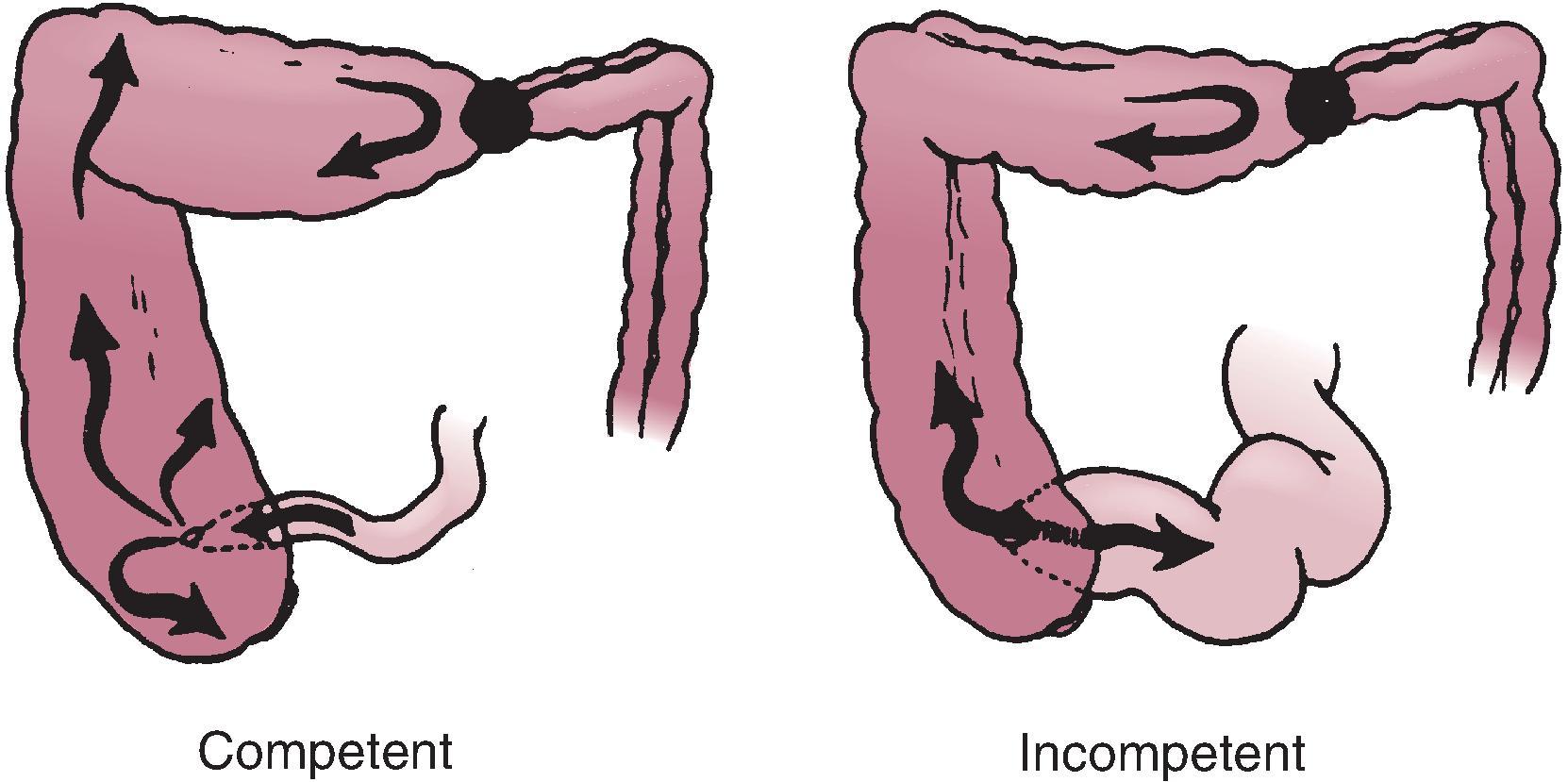
The cecum has the largest diameter of the colon, and therefore its wall develops the highest tension, according to Laplace’s law (wall tension = intraluminal pressure × radius). The increased pressure may cause separation of the muscle fibers, leading to cecal diastatic perforation. Dissection of air into the wall results in pneumatosis, which may precede frank perforation. , The risk of perforation increases when the cecum reaches a diameter of 9 to 12 cm. The duration and rapidity of onset of the distention are also important. , The intraluminal pressure needed to produce perforation is between 20 and 55 mm Hg. Ischemia and bacterial overgrowth also play a role in cecal perforation, and the systemic effects seen with strangulating obstruction. ,
Abdominal radiographs obtained in the supine and erect or left lateral decubitus positions are often the initial means of imaging patients with suspected obstruction. These radiographs may confirm the diagnosis, locate the site of obstruction, and, in some cases, identify the nature of the obstructing lesion. The colon is usually dilated proximal to the obstruction; however, if the ileocecal valve is incompetent, the appearance may mimic that of small bowel obstruction.
Computed tomography (CT) is now the imaging modality of choice for patients with known or suspected obstruction. It is the best noninvasive means of answering the following key questions:
Is the bowel obstructed?
What is the level of the obstruction?
What is the cause of the obstruction?
Is the obstruction simple or closed loop?
Are ischemic changes present?
Does the patient need immediate surgery, or should a trial of conservative therapy be attempted first?
Although CT is the best examination for evaluating patients with suspected colon obstruction, ultrasonography and magnetic resonance imaging (MRI) can also determine the level and cause of obstruction, particularly in children and pregnant women. ,
Large bowel obstruction is caused by intrinsic colon carcinoma in approximately 55% of cases. , Almost 20% of colon cancers are complicated by some degree of obstruction; 5% to 10% are complicated by complete obstruction, which requires emergent surgical intervention. , The mortality rate is high (10%–30%) in patients requiring emergency surgery, regardless of the site of tumor. , This is a reflection of advanced tumor stage, advanced patient age, and associated cardiorespiratory disease, malnutrition, sepsis, and surgical stress. Mortality is even higher if there is concurrent perforation.
The sigmoid colon is the most common site of obstructive colon cancer because of its relatively narrow diameter and solid fecal contents. The location of obstruction in one series was as follows: cecum, 11%; right colon, 5%; hepatic flexure, 3%; transverse colon, 11%; splenic flexure, 12%; descending colon, 10%; sigmoid colon, 35%; and rectum, 13%. The ratio of obstructing carcinomas to total tumors is similar in the right ( Fig. 46.2 ) and left colon but lower for rectal lesions. Tumors of the transverse colon and splenic flexure are at particular risk for obstruction before clinical detection. The risk of developing obstruction in tumors at a particular site has been estimated as 50% for splenic flexure lesions, 25% for right- and left-sided ones, and 6% for rectal tumors. Perforation occurs in 3% to 8% of patients with malignant obstruction. The most common site of perforation is the cecum rather than adjacent to the tumor.
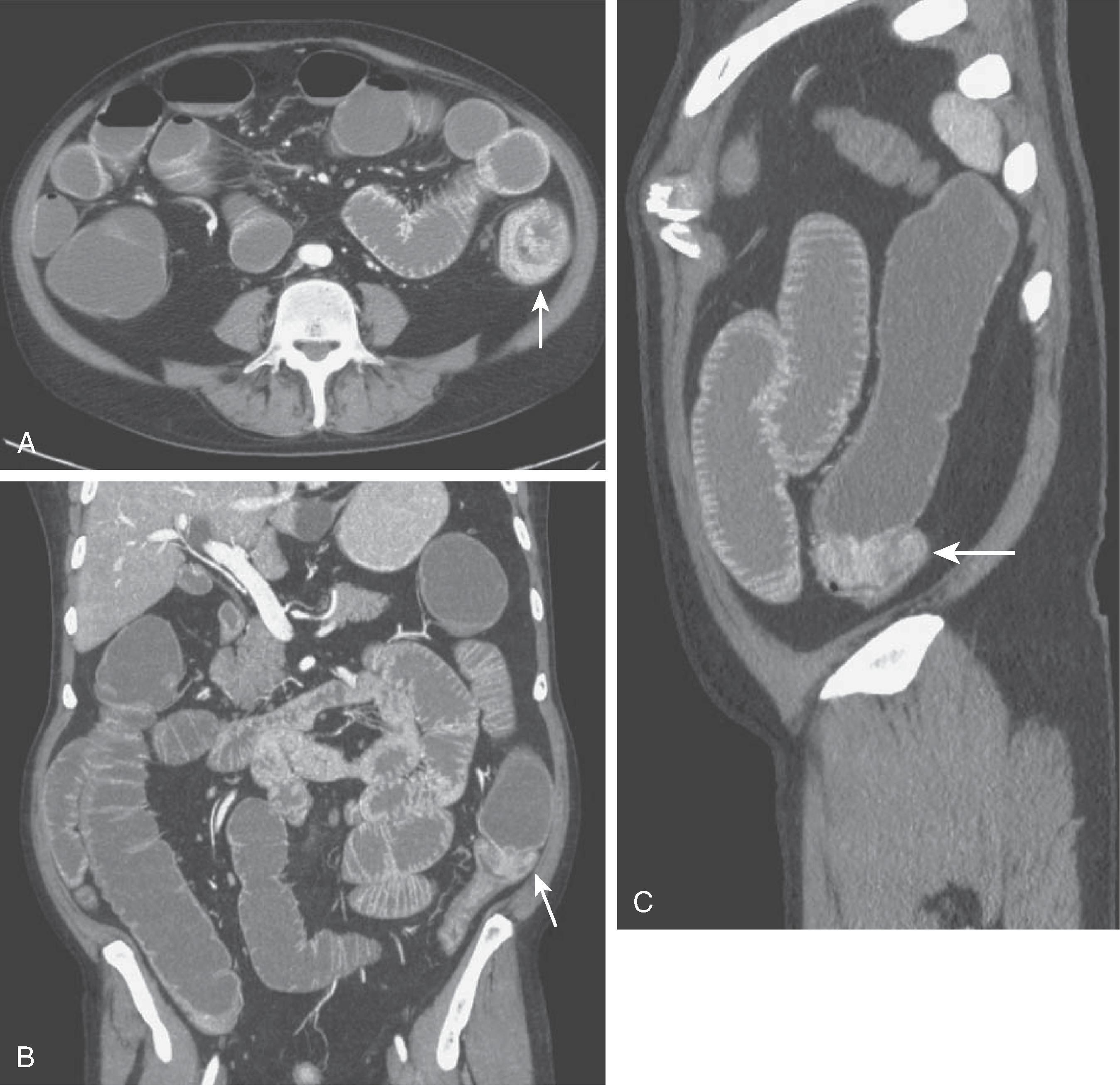
Large bowel obstruction is the result of diverticular disease in about 12% of cases. Diverticulitis can cause small and large bowel obstruction. Partial colonic obstruction can complicate acute diverticulitis as a consequence of edema and pericolic inflammation or abscess formation. High-grade obstruction is uncommon; it is far more frequently caused by carcinoma of the colon. Usually, obstruction follows recurrent attacks of diverticulitis, with marked fibrosis of the colon wall leading to narrowing and eventually stricture formation. The site of obstruction is usually in the sigmoid colon, near the site of inflammation. Obstruction of the transverse or right colon attributable to diverticulitis is rare.
Clinically, patients with sigmoid diverticulitis complain of left lower quadrant pain, fever, and abnormal bowel habits. It is important for these symptoms to be differentiated from those of carcinoma of the colon, an often difficult task clinically and radiologically ( Fig. 46.3 and Table 46.3 ). Symptoms of sigmoid colon cancer are usually more insidious, with rectal bleeding, constipation, and weight loss. ,
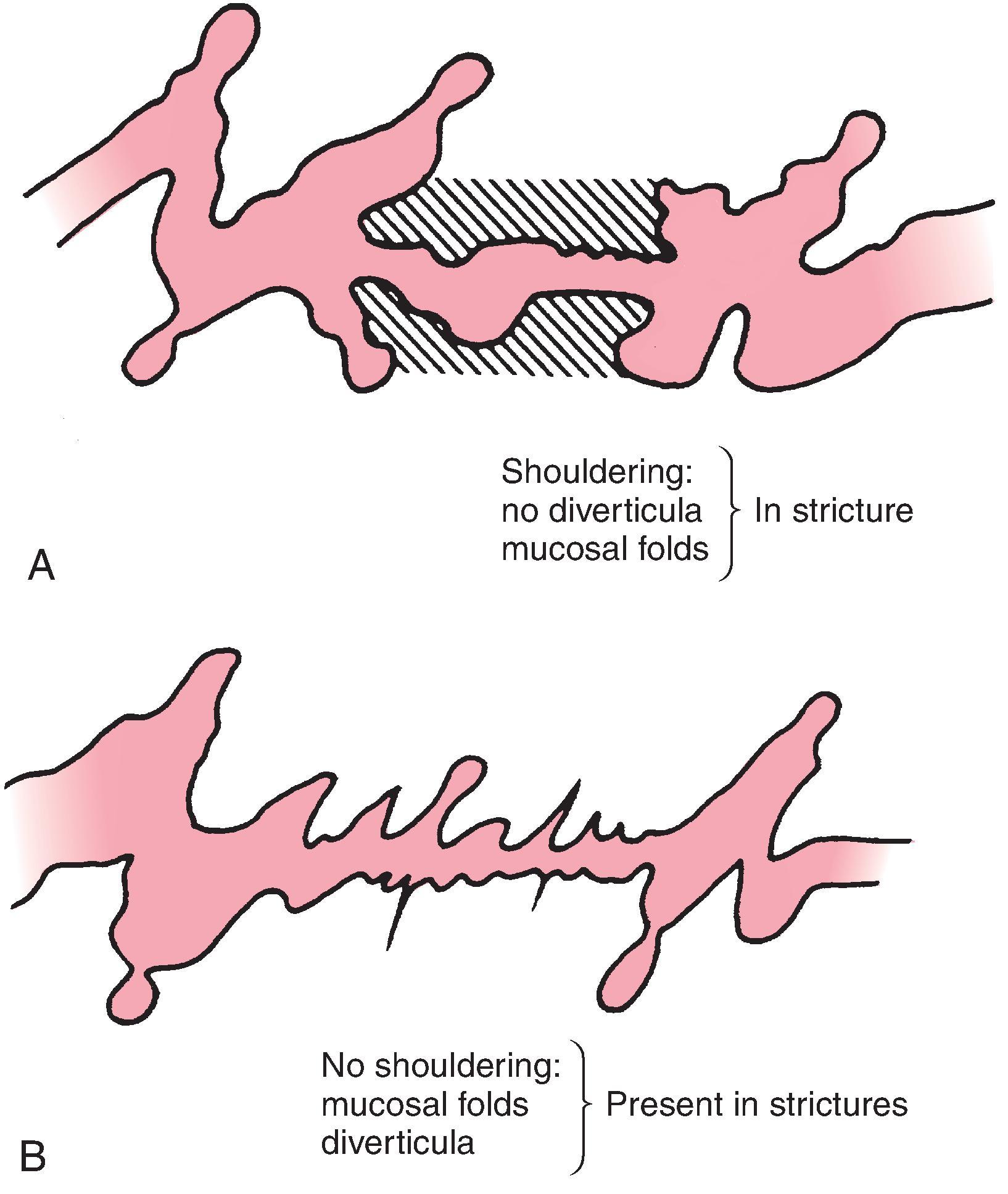
| Diverticulitis | Carcinoma |
|---|---|
| Spastic bowel | Normal adjacent bowel |
| Cone-shaped edges | Sharp margins, shelflike |
| Long segments | Short segments |
| Mucosa preserved | Mucosa destroyed |
| Variable constriction between examinations | Progressive obstruction |
| Diverticula present | Occasional diverticula |
| Obstruction without tumor | Obstruction with tumor |
Volvulus refers to torsion or twist of an organ on a pedicle to a degree sufficient to cause symptoms. Large bowel volvulus ( Fig. 46.4 ) accounts for about 10% of colon obstructions and can affect the sigmoid colon, cecum ( Figs. 46.5 and 46.6 ), transverse colon, and, rarely, the splenic flexure. Symptoms are caused by narrowing and obstruction of the gut, strangulation of the blood vessels, or both.
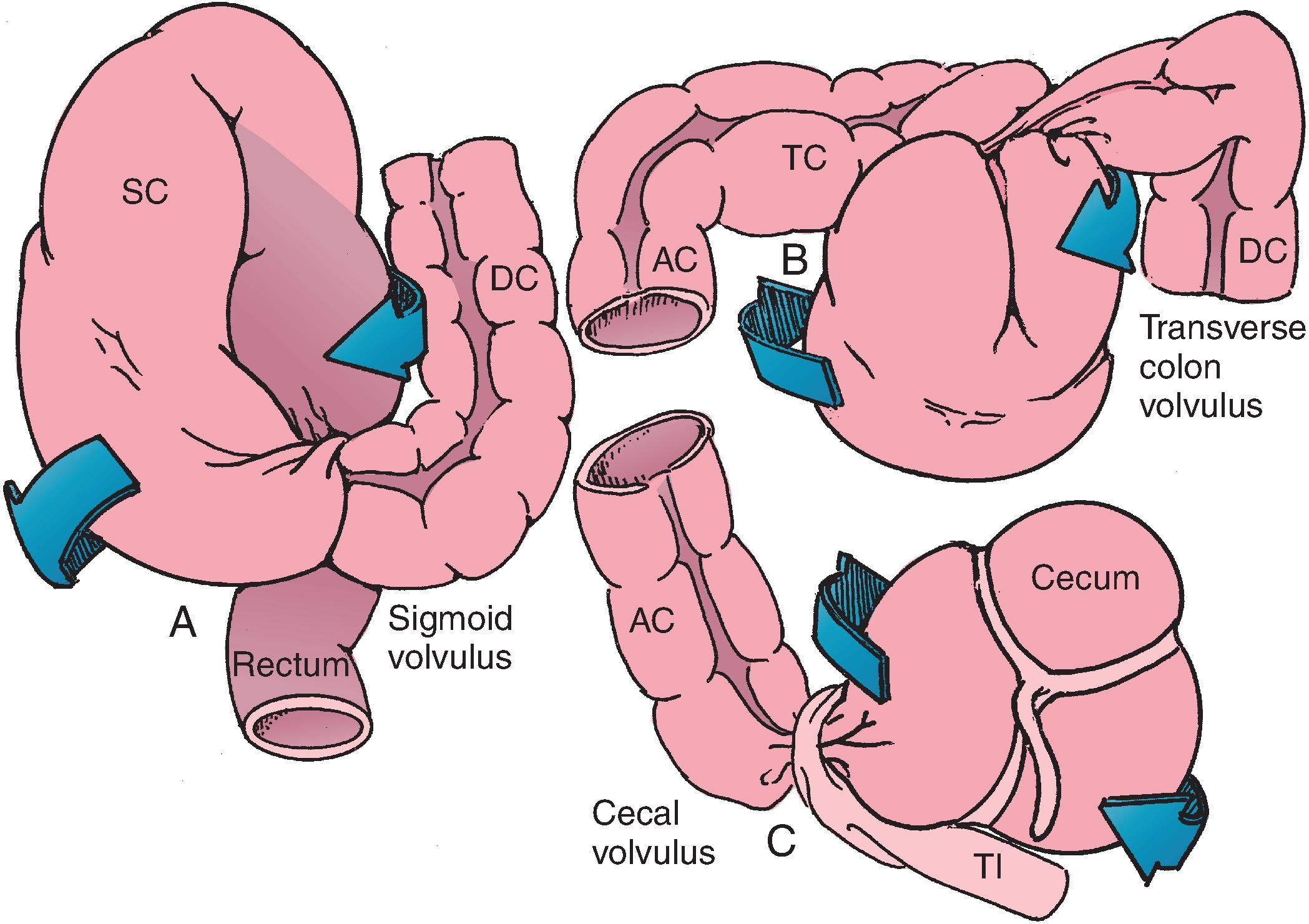
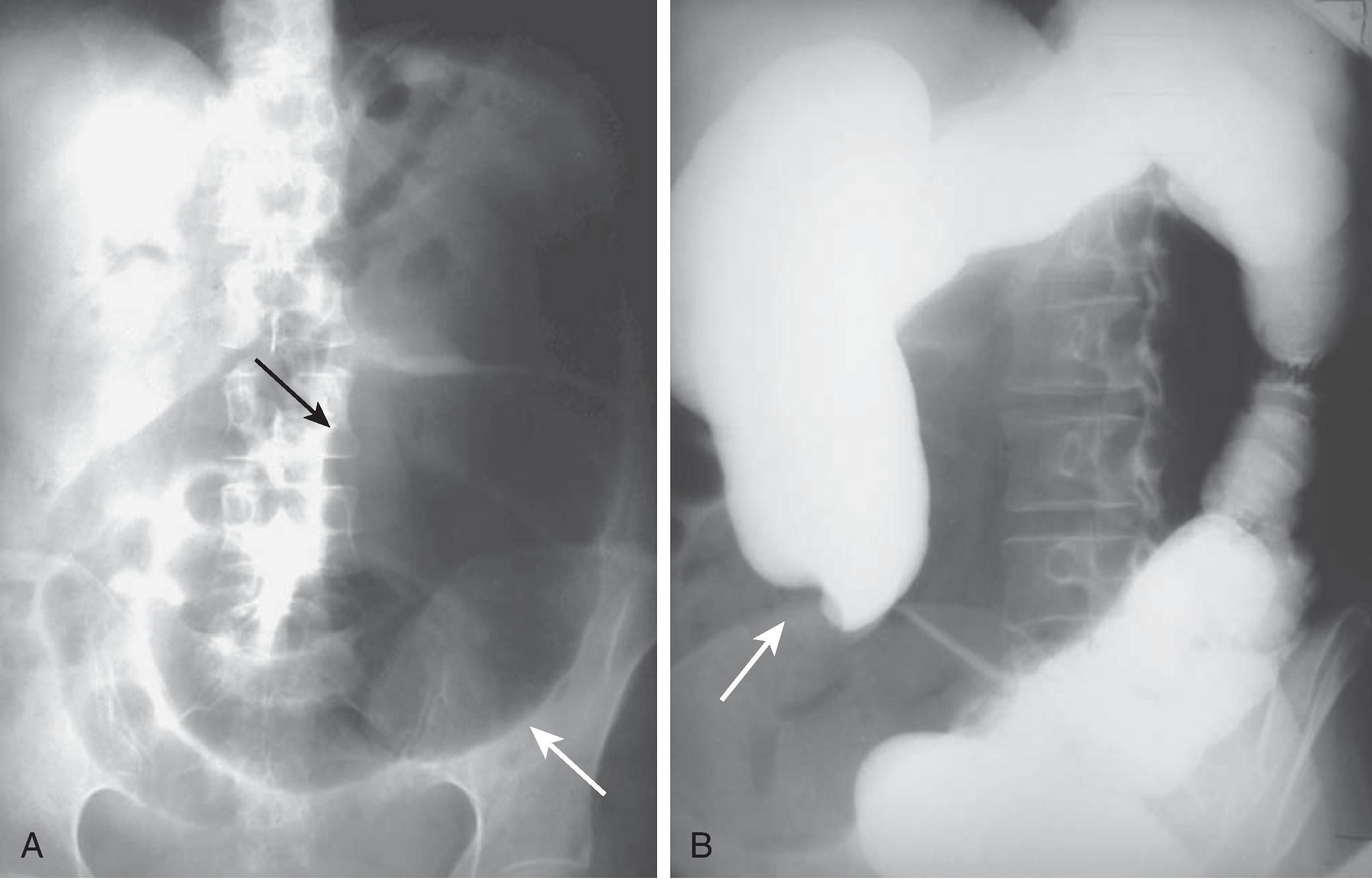
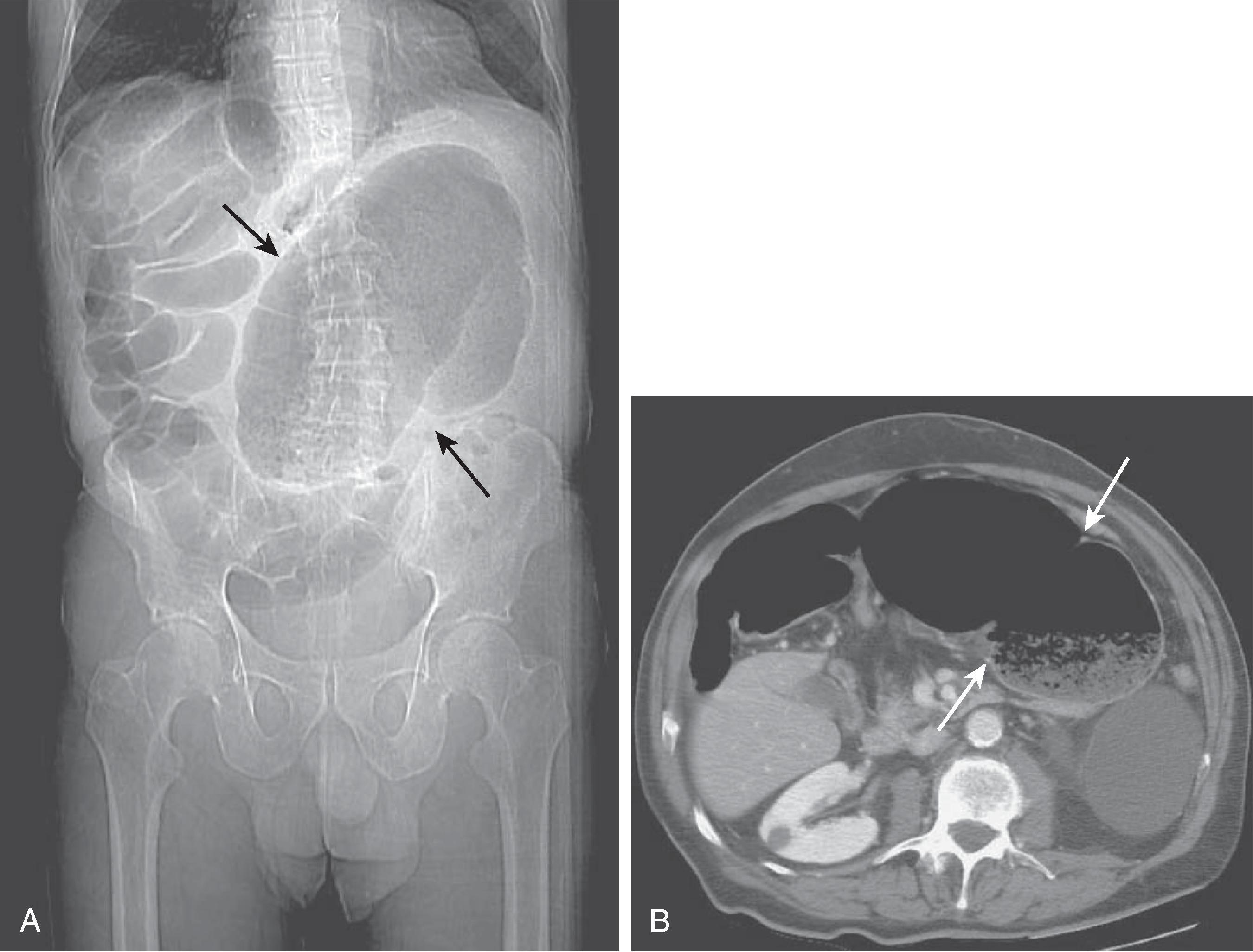
The major predisposing factors necessary for colonic volvulus are a segment of redundant mobile colon on a mesentery or mesocolon and a fixed point around which rotation can occur. The sigmoid colon ( Fig. 46.7 ) is, therefore, the most frequent site of colonic volvulus, especially in patients older than 60 years. Sigmoid volvulus is not caused by a congenital defect but by dietary and behavioral factors, including increased fiber in the diet, which increases the bulk of stool and elongates the colon. Cecal or ascending colon volvulus occurs in patients with a congenital defect in attachment of the right colon or postpartum ligamentous laxity and a mobile cecum. Anything that causes colon distention, including pseudo-obstruction, distal tumor, endoscopy, enemas, and postoperative ileus, may precipitate cecal volvulus in susceptible individuals. Transverse colon volvulus occurs in patients with a redundant transverse colon on a long mesentery, and splenic flexure volvulus occurs in patients with deficiency of the normal attachments of the splenic flexure to the posterior peritoneal wall, usually as a result of prior surgery. The frequency of colon volvulus is as follows: sigmoid colon, 50% to 75%; cecum, 25% to 40%; and transverse colon, 0% to 10%. A rare cause of combined colon and small bowel obstruction is the ileosigmoid knot.
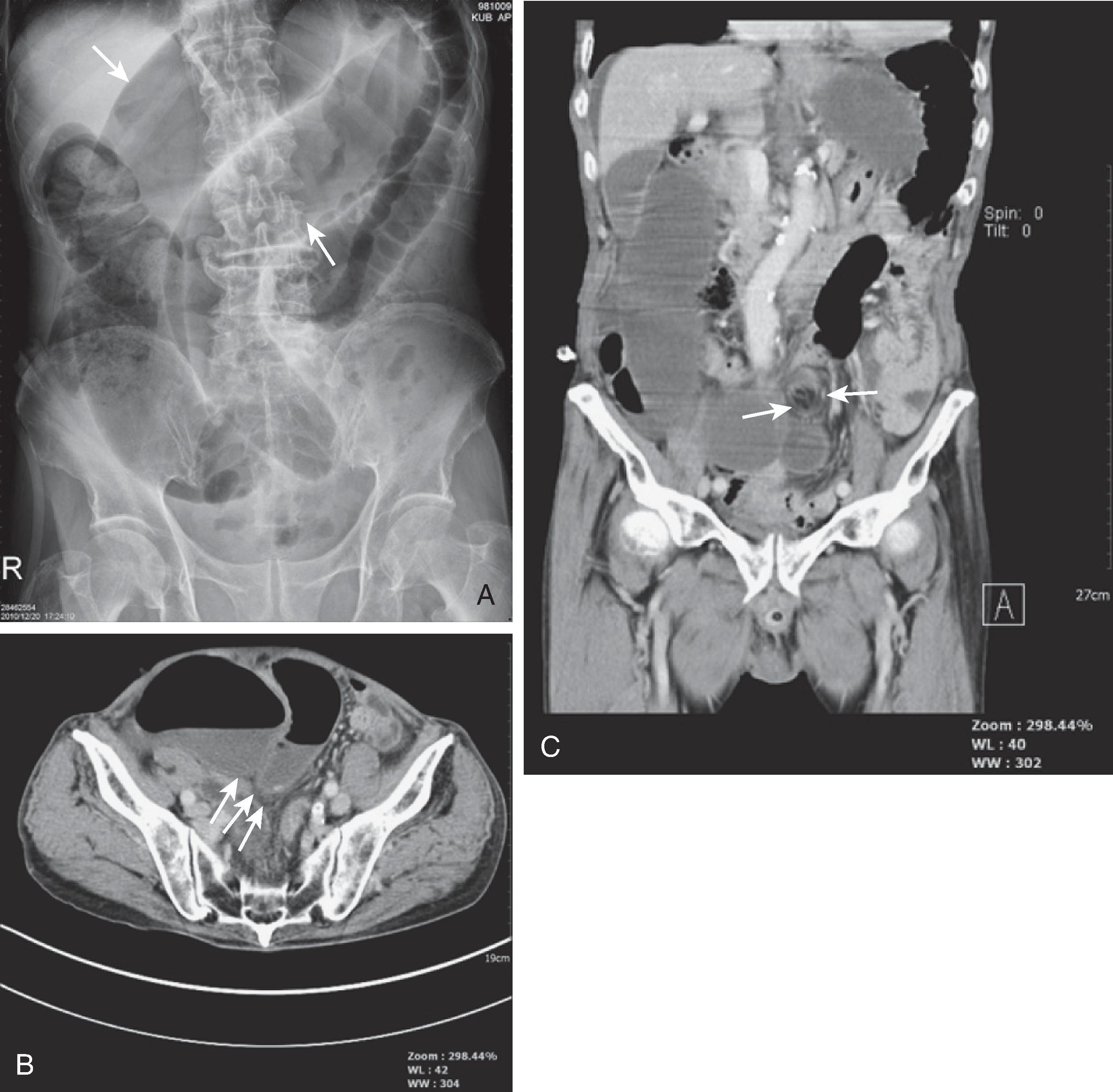
On CT, a whirl sign has been described in volvulus. The whirl is constituted by the afferent and efferent limbs leading into the volvulus. Tightly twisted mesentery and bowel compose the central portion of the whirl. The progressive tapering of the two limbs leading to the twist on CT corresponds to the so-called beak seen on barium enema. The distended and redundant sigmoid colon may overlie the liver and extend cephalad to the transverse colon (the so-called northern exposure sign).
Intussusception is defined as the invagination of one segment of the gastrointestinal (GI) tract into an adjacent one. It accounts for 80% to 90% of bowel obstruction in infants and children and ranks second only to appendicitis as the most common cause of an acute abdominal emergency in children. In children, intussusception usually begins in the distal ileum, and in 90% of cases the cause is idiopathic.
In contrast, intussusception in adults accounts for only 1% to 3% of mechanical intestinal obstruction, and a demonstrable cause is found in 80% of adult cases. Colonic intussusception is usually caused by a primary colon cancer, whereas small bowel intussusception is generally related to a benign tumor and less often to a malignancy, usually a metastatic lesion. Postoperative intussusceptions usually occur in the small bowel and are related to a number of factors, such as suture lines, ostomy closure, adhesions, long intestinal tubes, bypassed intestinal segments, submucosal edema, abnormal bowel motility, electrolyte imbalance, and chronic dilation of the bowel.
Benign lesions that can serve as lead points in colonic intussusception include adenomatous polyps, lipomas, GI stromal tumors, appendiceal stump granulomas, and villous adenomas of the appendix. The normal appendix may transiently intussuscept, although clinically significant appendiceal intussusception usually occurs in the setting of appendiceal inflammation, infestation, neoplasm, or endometriosis deposition. Colonic intussusception has also been reported as a complication of eosinophilic colitis, epiploic appendagitis, and pseudomembranous colitis.
The classic appearance of intussusception on barium studies is the coiled spring appearance as contrast is trapped between the intussusceptum and intussuscipiens ( Fig. 46.8 ).
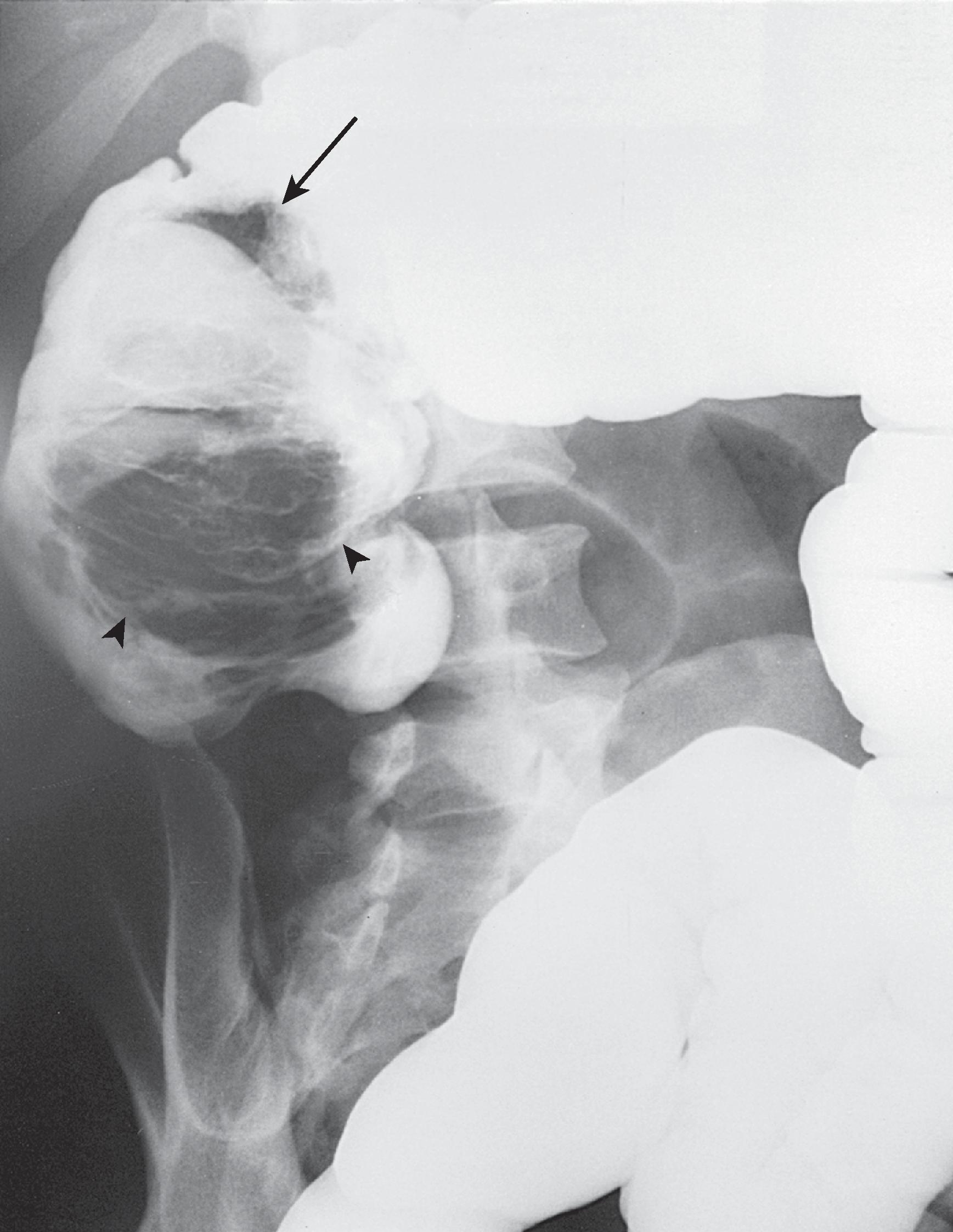
Ultrasound shows a target-like lesion, in which the hypoechoic halo is produced by the mesentery and edematous wall of the intussuscipiens, and the hyperechoic center is produced by multiple interfaces of compressed mucosal, submucosal, and serosal surfaces of the intussusceptum. Multiple concentric rings, best seen on transverse scans, are also characteristic. The corresponding appearance on longitudinal scans is that of multiple, thin, parallel, hypoechoic, and echogenic stripes.
On CT, intussusceptions appear as three different patterns, which reflect their severity and duration: (1) the target sign; (2) a sausage-shaped mass, with alternating layers of low and high attenuation; and (3) a reniform mass. Pathophysiologically, the target is the earliest stage of intussusception. As it progresses, a layering pattern develops, with alternating low-attenuation (mesenteric fat) and high-attenuation areas (bowel wall) ( Fig. 46.9 ). If intussusception is untreated, edema and mural thickening develop. An intussusception with a reniform appearance is caused by severe edema and vascular compromise, which constitutes a surgical emergency. Intussusception is almost invariably associated with acute intestinal obstruction or partial and recurrent obstruction, air-fluid levels, and proximal bowel distention. The mesenteric arcade associated with the intussuscipiens may show traction. If infarction occurs, this mass may be surrounded by intraperitoneal fluid, edema, hemorrhage in the mesentery, and even perforation. , CT can diagnose lipoma as the lead point; however, with varying degrees of infarction and fat necrosis, lipomas may have an atypical appearance.

Become a Clinical Tree membership for Full access and enjoy Unlimited articles
If you are a member. Log in here